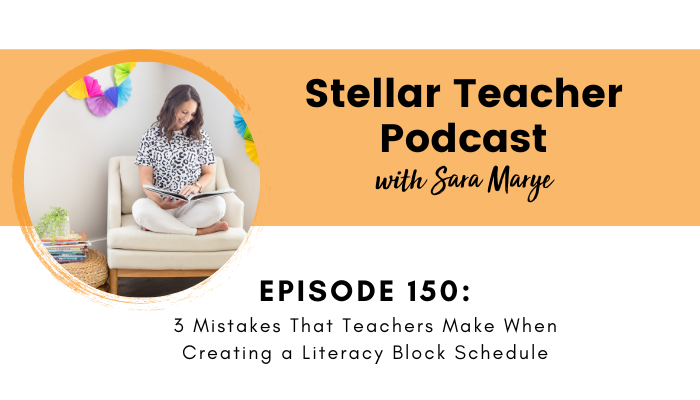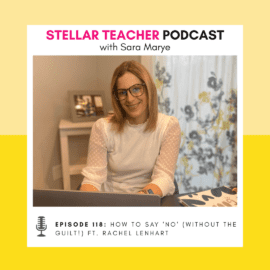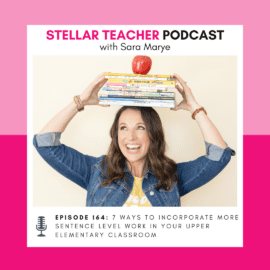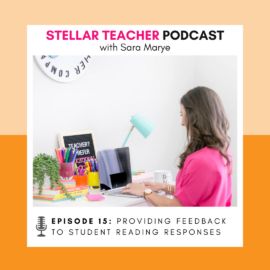
Click play below to hear ways to improve your literacy block schedule:
The number one question I get asked the most is How do I fit everything I need to in my literacy block? And while I wish I could grant you all the time you need, I can’t. However, being in the classroom myself, I made some mistakes that I hope to share with you that you can learn from going forward. So in today’s episode, I’m sharing the 3 mistakes teachers make when creating their literacy block schedule.
Going back to the idea of fitting it all in, you probably can’t. But you can get close if you improve your time management, which boils down to how you choose to set up and structure your literacy block. When determining your literacy block schedule, it’s important to take into account your expectations, transition times, and being realistic about what you can actually get done during that time.
We have so much that we want to get through during our literacy block, so I’m here to help you find ways to improve your time management. I help provide you strategies and ideas that get you thinking more realistically regarding your literacy block schedule. Learn from my mistakes and your literacy block will run smoothly that’s filled with meaningful content!
In this episode on your literacy block schedule, I share:
- Ways to improve your time management during your literacy block
- Two things you can do that help set realistic expectations during that block
- Why creating systems and routines saves you time
- How to account for the human factor when creating your literacy block schedule
- A bonus mistake that many teachers make
Resources:
- Sign up for my Private Podcast: Confident Writer Systems Series
- Check out the Stellar Literacy Collective Membership
- If you’re enjoying this podcast, please leave a review on Apple Podcasts!
Related episodes and blog posts:
- Episode 144, Get More Out of Your Literacy Block With a Strong Whole Group Lesson Routine
- Episode 81, 5 Steps Toward a More Efficient Schedule
- Episode 59, Simplifying the Struggle of Fitting Everything Into Your Literacy Block
- Episode 27, Create a Schedule for Your Reading Block – Even with Limited Time!
Connect with me:
- Join my newsletter
- Shop my TPT store here
- Instagram: @thestellarteachercompany
More About Stellar Teacher Podcast:
Welcome to the Stellar Teacher Podcast! We believe teaching literacy is a skill. It takes a lot of time, practice, and effort to be good at it. This podcast will show you how to level up your literacy instruction and make a massive impact with your students, all while having a little fun!
Your host, Sara Marye, is a literacy specialist passionate about helping elementary teachers around the world pass on their love of reading to their students. She has over a decade of experience working as a classroom teacher and school administrator. Sara has made it her mission to create high quality no-fluff resources and lesson ideas that are both meaningful and engaging for young readers.
Each week, Sara and her guests will share their knowledge, tips, and tricks so that you can feel confident in your ability to transform your students into life-long readers.
Tune in on your favorite podcast platform: Apple, Google, Amazon, Spotify, Stitcher, and more! If you’re loving this podcast, please rate, review, and follow!
Podcast (stellar-teacher-podcast): Play in new window | Download
Hey, there teachers and welcome back. Today we are going to talk about something that I bet you can relate to. And that has to do with time management. And time management is a big challenge for teachers. It was a challenge for me when I was in the classroom.
And so many teachers reach out to me and say things like, I am struggling to fit it all in. Or they ask questions like, how do you find time to teach everything? Or they just share, I need help fitting everything into my language arts block. How do I fit it all in?
And that is probably the number one question that I get from teachers, how do I fit it all in? And I think it’s valid. I definitely struggled with time management at times when I was teaching. Upper elementary reading and writing teachers have a lot on their teacher plate, whole group lessons, small group lessons independent practice, read aloud, spelling, grammar, writing vocabulary, trying to catch our students up to grade level, the list goes on and on.
And it can feel nearly impossible to find a way to fit everything in. But there are definitely things that we can do to improve our time management. And I think it really starts with how we choose to set up and structure our literacy block.
So scheduling, obviously, we can put anything we want on paper. But we want to create a realistic schedule, because when we do, we are much more likely to stick to it. It doesn’t matter if on paper, our literacy block works if we’re not able to actually put that schedule into reality.
So let’s jump into today’s episode, where I want to share with you the three mistakes that teachers make when creating their literacy block schedule. And as you know, anytime I have an episode that is focused on mistakes, these are things that I did that I have learned from that, I hope that you can also learn from my mistakes and not repeat them.
Now, I think the first thing and this is maybe the biggest mistake is when we are unrealistic about what we can get done in a day. And while I think that most teachers really are superheroes or as close to a superhero as you can get, we do have some actual limitations. And unfortunately, one of them is time.
And I think that the biggest mistake that we make when it comes to scheduling is thinking that we can get more done in a day or in a 90 minute literacy block than we actually can. And even if we have the best of intentions, you know, and even if we want to meet with small groups every day, and even if we want to do a read aloud every day, and we want to have these high quality, engaging, exciting lessons every day, we are limited by time.
And the thing that I’ve learned in life. And this is true, not only with teaching, but disappointment and frustration in life happens when there is a gap between our expectations and what actually happens in reality.
And I think this is why teachers always feel so frustrated with their schedule, because their expectation is that they can fit it all in and that they are going to meet with every group every day, and that they are going to be able to, you know, do a read aloud every day and their students behavior is going to you know, not prevent them from getting through their lessons, whatever it is, you have that expectation in your head. But usually that’s not actually what happens. And so then you have that room for disappointment and frustration to come in.
So one of the things that you can do to help yourself is to be really realistic and honest with yourself about your expectations for your literacy block. Now, this doesn’t mean that you’re lowering your expectations, this just means that you’re changing them to be realistic.
So two things that you can do to help yourself be realistic about what you can get done and your literacy block is first of all, do a time audit. Now I know that many of you are on summer break right now. So this is not necessarily something that you can do. But when you get back to school, and after the first couple of weeks in fact I would get out your calendar right now. And for the like third week of school, make a note to yourself to remind yourself to do a time audit.
And a time audit is simply where you time yourself for each part of your literacy block to see how long does it take. You know because in your head and on paper, you might think that your small group is only 15 minutes. But actually, when you time yourself, you realize that it actually took you 18 minutes. And those three minutes makes a big difference when you’re trying to fit everything in.
So do a time audit to actually see how much time are you spending or does it take you to go through each part of your literacy block? Because that’s going to help you know, what do you actually have time for.
But one of the things that you can do right now this summer, is to brain dump all of the things you want to get done during your literacy block. So that’s just literally writing down making a list of what would your literacy block look like on a daily basis? You know, or how are you planning on teaching it?
And you can start with your ideal, you know, but more than likely, you’re going to have to eliminate some things. But once you have your schedule written down, actually take each element of your literacy block, and break them down into very small time increments, to see if you actually have time to get through what you think you’re going to get through.
So for example, if you’re saying, I’m going to have two small groups every day, they’re going to be 15 minutes each. So think about how do you actually plan on spending your 15 minutes? Okay, well, maybe you’re going to be realistic and say there’s going to be a transition to the table, which is one minute, I’m going to introduce and teach an objective, that’s three minutes. We’re going to have guided practice, that’s eight minutes closure, that’s two minutes transition from the table one minute.
Okay, so while all of those minutes total up to 15, the thing that we are forgetting is the human factor, our students, and during our small group, we’re going to be asking questions, we’re going to be getting students to engage, we’re going to be supporting students, we might realize a student needs a little bit more of our attention. And more than likely, this human factor of our students is going to take more time than we allotted.
So we need to be realistic about how student engagement and participation impacts the schedule we write down on paper. So really, whatever time you think it’s going to take you, we really need to add in some buffer time and some additional time for all parts of our literacy block to account for student engagement. And adding in this extra time for student engagement is going to help you create a much more realistic literacy block schedule.
Okay, the second mistake that we make as teachers is not creating systems or routines for each part of our literacy block. I love a system I love a routine. And this is something that we really love helping the teachers inside our membership, the Stellar Literacy Collective with, you know, the most of our resources are created based off of a routine or a system.
And when you’re trying to fit everything in a routine or a system is going to be your best friend. And it’s going to be a lifesaver. When you use routines, you are creating a predictable set of steps and behaviors for both you and your students to follow. If the actions that you and your students take are predictable, then there’s less time spent giving directions and managing student behavior, which means more time to actually get through the lesson.
Systems and routines are a total time saver. And they really do allow you to get more done. And I encourage teachers to have a routine for all parts of your literacy block, have a routine for small group have a routine for your centers have routine for your word study have a routine for your read aloud, every part of your literacy block should be broken down into routine.
So if you teach a whole group lesson, teach it the same way every single day. If you always have students engage with a turn and talk, you know during your read aloud, then always have them do it the same way every day.
And if you happened to listen to my guest interview a couple of weeks back with Kelsey Moody, who is one of our members inside the Stellar Literacy Collective, she talked about how one of the biggest lessons she learned during her first years of teaching is how important it is to use routines.
She explained to me that routines made it easier for herself as far as lesson planning goes. But it made it a lot easier for her students to know what to do, and how to engage during the lessons and they weren’t a total time saver for her.
So if you don’t have routines in your literacy block yet, come up with them. And we have a ton of routines that we have developed and shared through our resources and that we use with the teachers in our membership. And some examples. And you’ve heard me talk about some of these on the podcast before but we use what I like to call the 4T model, which is our framework for small group. That’s a routine.
We have a six step process for teaching Paragraph Writing. That’s a routine. We have a word of the week routine for vocabulary with specific tasks each day of the week. But you can come up with your own routines and you can come up with routine for any part of your literacy block. And really, you should do it for all parts of your literacy block.
So sit down, take a few minutes, think about you know, how do I want each part of my literacy block to look and flow? What do I want my read aloud to look like? What do I want my students to do? What actions do I need to take? What materials are needed? How much time is needed?
And if you ask yourself these four questions for all parts of your literacy block your read aloud your word, study your centers, your small group, your writing, whatever parts you include, you’re going to be able to come up with a routine. Because whatever you come up with, you’re just going to rinse and repeat every single day.
Now, I’ve had some people suggest or wonder, you know, that if we use a routine for everything isn’t that boring. And, you know, we want to keep our students engaged and excited. So I want to switch things up. And you know, I want I don’t want to do the same thing every single day.
And my argument for that, or my response to that, really is that I think routines actually help students develop confident, and independence. And when our students are confident, and independent, that is going to lead to a much higher and more authentic level of engagement and enjoyment than any sort of, you know, new, shiny, fun activity that you can do once in a while. So I really do think routines are timesavers, and they give you a great boost to engagement as well.
Okay, the third mistake that teachers make when putting together their literacy block schedule, is not accounting for transition times. And I kind of alluded to this a little bit earlier, but I think it deserves its own bullet point.
When we’re creating our schedule, we forget the amount of time that it takes our students to transition. Now, even if you’re departmentalized, and your students are with another teacher for math, and they transition into your room for literacy, you still have multiple transitions within your literacy block.
You know, you’re trying to do word study and hold group lessons and small group lessons and read aloud and writing. And maybe you’re doing two small group lessons. So at the very least, you have six transitions during your literacy block if you’re trying to do all of those things I mentioned. And the more elements you include, the more transitions you have.
And let’s just say that it takes your students a minute for each transition, that’s six minutes of lost instructional time. And if you only have a 60 minute literacy block, that’s 10% of your literacy block, I think I hope my math is right there.
Now, this means if you have six minutes of unaccounted for transitional time, when you get to the end of your literacy block, let’s say writing is the very last thing in your literacy block, you’re either going to have to cut your writing lesson short, or you’re gonna have to skip it altogether, because you had six minutes of transition time that you didn’t account for, which is cutting into your actual teaching time.
So if we want to be efficient with our schedules, then we need to be sure that we consider and account for the amount of time it takes for us to transition between activities in our literacy block. And we need to have those on our schedule.
It’s also a good reminder to practice transitions with your students, and make sure that they are not taking up a ton of time. You know, one minute is actually a pretty efficient transition time, especially if our students are having to put away or get out materials. You know, most transitions in our classroom are probably closer to 90 seconds, or maybe even two minutes. So just be aware that transition times need to be considered and ideally improved, when you are thinking about and putting together your literacy block schedule.
So those are my three tips. But because I can’t help myself, I have one more bonus sort of mistake that I want to share with you. And I actually think that this is a big one. And while I don’t necessarily have practical tips for it, I think it’s important to keep in mind.
A big mistake that we make is wasting energy focusing on what we can’t control. And I get it, I hear from so many teachers where it’s like, I only have an hour and a half to teach reading and writing and everything. And I don’t have enough time. And that is really, that’s unfair, you should have more time to do that. But it can be so easy to complain about how much time you don’t have to teach literacy.
But the reality of it is the amount of time that you have is completely out of your control your school or your district is giving you an allotted amount of time. And you don’t really have a say in that. And I wish you did. But you don’t. And there is no point in getting upset or complaining or dwelling on something that you don’t have control over. That just is going to create emotional exhaustion and it’s just going to be really draining for you.
So it’s okay to be mad about it. It’s okay to be frustrated about it. Give yourself a you know, 15 minute pity party, maybe not even that long, get your frustration out, and then decide, okay, I’m just going to accept this. And I’m going to do everything I can to make the most of this time. Because there are things that you can do to maximize your time.
The easy way would be to say give me 30 more minutes. The really challenging and kind of the fun part is to say you know what, I only have 60 minutes, but I’m going to figure it out. I can figure out how to use that 60 minutes to fit everything in. So let me just encourage you release any sort of negative feelings or frustrations you have about your schedule, because you can’t control it.
But hopefully you will get some strategies and ideas that will make you feel all like, you know what I know how to put my schedule together and to fit everything in, even if it’s only 60 minutes.
So let’s recap, I hope you will learn from my mistakes. And instead of doing what I did, I hope you will be realistic about what you can get done in a day. Don’t put more on your plate, then you can actually get done. Create systems and routines for all parts of your literacy block, include transition times in your schedule, and don’t forget to account for the human factor. And then finally, my bonus tip was stop wasting energy focusing on what you can’t control.
Now I really hope that this episode served you as you start to think about returning to school this fall, know that you might not get your schedule 100% perfect, and it might be difficult to put all four of these things in place at once. But pick one, get started with it. And then hopefully you can come back and continue to implement all four of the suggestions that I shared in this episode. I hope you have a stellar week. See you back here next Monday.








Leave a Comment
You must be logged in to post a comment.